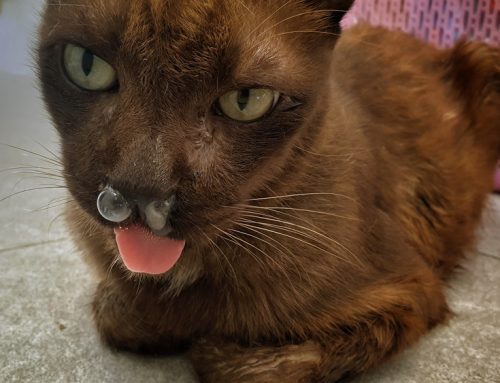If you own a cat, you know they can be sweet, mysterious, rambunctious, mischievous, hysterical, and everything in between. They are also excellent at relieving your stress at the end of a hectic day. Our Town and Country Animal Hospital team shares some intriguing, and sometimes surprising, facts about cats that may have you reassessing your four-legged friend.
#1: Your cat’s purr has healing qualities
Every cat owner loves to hear their cat purr. However, most believe that purring is simply a way to express contentment, but your cat’s purr has healing qualities for themselves—and for you—including:
- Stress — When a cat purrs, endorphins are released inside their brain, and humans who hear a cat purring also experience an endorphin release. These hormones reduce stress levels and have also been shown to lower blood pressure levels.
- Bones — Cats typically purr at a frequency between 25 Hz and 140 Hz. In human medicine, these frequencies have been used to promote bone tissue healing, so cats may experience few bone abnormalities because they purr. Purring may be a low energy way to keep bones and other tissues healthy while the cat rests.
- Respiratory conditions — Cats with respiratory conditions that cause breathing difficulty often start purring, which seems to help them breathe more easily.
- Heart conditions — Studies have demonstrated that people exposed to a purring cat are about 40% less likely to have a heart attack. The calming effect relieves stress and lowers blood pressure, reducing heart disease risk.
- Migraines — Anecdotal evidence suggests that a purring cat may help people cope with migraine pain, and help resolve migraines.
#2: Your cat cannot taste sweets
Mammals have taste receptors on their tongues, which are proteins on the cellular surface that bind to an incoming substance, and activate the cell to signal the brain. Humans have five kinds of taste receptors, including sour, bitter, salty, meatiness, and sweet—and some experts also include fat. The sweet taste receptor is generated by two genes known as Tas1r2 and Tas1r3. The cat’s digestive tract is specifically adapted to digest a meat-based diet, and cats lack the Tas1r2 gene, so they cannot appreciate sweets like humans. However, they can taste flavors we can’t, such as adenosine triphosphate (ATP), the compound that supplies energy to living cells. Cats may also lack other factors that allow the body to digest sugars, such as glucokinase, an enzyme that controls carbohydrate metabolism and prevents blood glucose spikes. This may be why more cats are getting diabetes, because many cat foods have around 20% carbohydrates, which cats can’t metabolize appropriately.
#3: Your cat’s whiskers are well honed sensory tools
Cats typically have 12 whiskers on each cheek, arranged in four horizontal rows of three. They also have whiskers on their jaw, above their eyes, near their ears, and on their forelegs. Each whisker is deeply embedded and connected to the nervous system, and sends messages to the brain to help the cat determine an object’s distance, direction, and surface texture. Other fun whisker facts include:
- A cat’s whiskers are proportionate to their body width — Cats use their whiskers to determine if they can fit through narrow spaces.
- Cats can experience whisker stress — A cat’s whiskers are so sensitive that a cat who eats or drinks from a narrow bowl can experience irritation known as whisker stress. If your cat is scooping food from their bowl, you may consider getting a wider one.
- Leg whiskers help your cat hunt — The whiskers on the back of your cat’s forelimbs help them know if their prey is still moving and in a position that will allow them to deliver a fatal bite.
- Whiskers can communicate the cat’s mood — Relaxed whiskers indicate a content cat, and pinned back whiskers indicate a scared cat. Whiskers held in a forward position indicate alertness if the cat’s ears are forward, but signal aggression if the cat’s ears are back.
#4: Your cat can rotate their ears 180 degrees

Cats have 32 muscles controlling each ear, which allows them to rotate their ear 180 degrees and increases their hearing sensitivity by 15% to 20%. Other interesting cat ear facts include:
- Cats have excellent hearing — Cats can hear lower and higher frequencies than dogs and people, allowing them to detect prey while avoiding predators.
- Your cat’s ear temperature can indicate stress — Studies have demonstrated that the temperature of a cat’s right ear is related to cortisol levels in the blood and can reliably indicate psychological stress.
- Many blue-eyed cats are deaf — According to the Cornell Feline Health Center, 40% of white cats with one blue eye are deaf, and 65% to 85% of white cats with two blue eyes are deaf. A genetic mutation that creates the blue eyes and white hair also causes malformations inside the ear, leading to deafness.
Hopefully, these interesting facts help you appreciate your cat a little more. If your rambunctious, mischievous cat has suddenly become quiet and lethargic, contact our American Animal Hospital Association (AAHA)-accredited team at Town and Country Animal Hospital PC, so we can determine why their behavior has changed, and get them back to their usual antics as soon as possible.







Leave A Comment